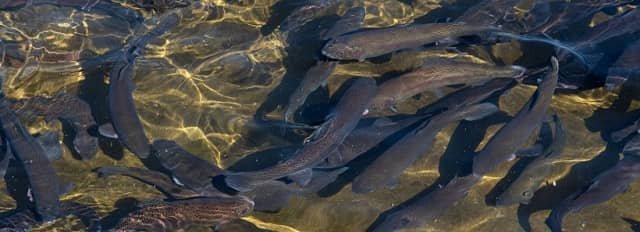Researchers from the Università degli Studi di Milano and the Norwegian University of Science and Technology characterized the potential biological activities of low molecular weight peptides isolated from rainbow trout (Oncorhynchus mykiss) obtained by enzymatic hydrolysis.
Due to the excellent physicochemical characteristics and amino acid composition, the researchers seek to valorize the <3 kDa fraction of the fish protein hydrolyzate.
Bioactive peptides
Bioactive peptides are defined as a group of peptides that have biological functions in a cell or in a living organism, and that play important roles in physiological functions and pathogenesis.
There is abundant scientific evidence that reports the biological activities of peptides and proteins obtained from mollusks, crustaceans, and fish waste (heads, intestines, skin, and fins).
By-products derived from marine organisms provide many bioactive molecules, such as collagen, antioxidants, chitin, and polyunsaturated fatty acids, and are notably a great source of protein.
Physicochemical characteristics of trout peptides
In previous studies, the researchers characterized the physicochemical characteristics of peptides isolated from rainbow trout (O. mykiss).
It has been shown that trout proteins and by-products can be used to produce hydrolysates with antioxidant, anticancer, and antibacterial activities.
Antioxidant and antidiabetic activity
To achieve their research goals, the scientists tested direct antioxidant activity using different in vitro antioxidant assays, namely DPPH, ferric reducing antioxidant potency (FRAP), and 2,2-azino-bis-(3-ethylbenzothiazoline-6- sulfonic acid) (ABTS) and at the cellular level.
Stay Always Informed
Join our communities to instantly receive the most important news, reports, and analysis from the aquaculture industry.
They also biochemically evaluated the ability of fish protein hydrolyzate (FPH) to decrease the activity of DPP-IV and ACE enzymes. Then, the antioxidant activity of FPH was measured by evaluating its ability to decrease the intracellular ROS level, lipid peroxidation, and NO levels in Caco-2 cells, where oxidative stress was induced by H2O2.
On the other hand, the antidiabetic activity was evaluated by measuring the ability of the hydrolyzate to inhibit, in Caco-2 cells, the activity of the DPP-IV enzyme that is expressed on the surface of the cell membrane.
Potential for human health
The researchers report that marine-derived peptides, in addition to having antioxidant activity, also exhibit ACE and dipeptidyl peptidase (DPP-IV) inhibitory properties, which could lead to their potential use as functional food ingredients for the treatment of hypertension and type II diabetes.
“In light of these observations, our study clearly demonstrated that fish protein hydrolyzate has a multifunctional behavior that can exert inhibitory activities on antioxidants, DPP-IV, and ACE,” they point out.
Likewise, they describe that based on a multidisciplinary approach, the research offers in vitro evidence on the health-promoting activity of fish protein hydrolyzate, which could be the basis for the creation of new dietary supplements and/or functional foods.
Conclusion
The results of the study indicate that peptides derived from rainbow trout may have the potential for use as health-promoting ingredients.
“Of course, we are aware that this is the initial phase of this process and that an in vivo study in animal models is undoubtedly required to achieve proof of concept on the safety of the ingredients and the healthy activity of this hydrolyzate. ”, recommend the researchers.
The study was funded by the Era-Net BlueBio project “IMPRESSIVE-Improved Processing to Enhance Seafood Sidestream Valorization and Exploration”.
Reference (free access)
Bartolomei, Martina, Janna Cropotova, Carlotta Bollati, Kristine Kvangarsnes, Lorenza d’Adduzio, Jianqiang Li, Giovanna Boschin, and Carmen Lammi. 2023. “Rainbow Trout (Oncorhynchus mykiss) as Source of Multifunctional Peptides with Antioxidant, ACE and DPP-IV Inhibitory Activities” Nutrients 15, no. 4:829. https://doi.org/10.3390/nu15040829
Editor at the digital magazine AquaHoy. He holds a degree in Aquaculture Biology from the National University of Santa (UNS) and a Master’s degree in Science and Innovation Management from the Polytechnic University of Valencia, with postgraduate diplomas in Business Innovation and Innovation Management. He possesses extensive experience in the aquaculture and fisheries sector, having led the Fisheries Innovation Unit of the National Program for Innovation in Fisheries and Aquaculture (PNIPA). He has served as a senior consultant in technology watch, an innovation project formulator and advisor, and a lecturer at UNS. He is a member of the Peruvian College of Biologists and was recognized by the World Aquaculture Society (WAS) in 2016 for his contribution to aquaculture.




